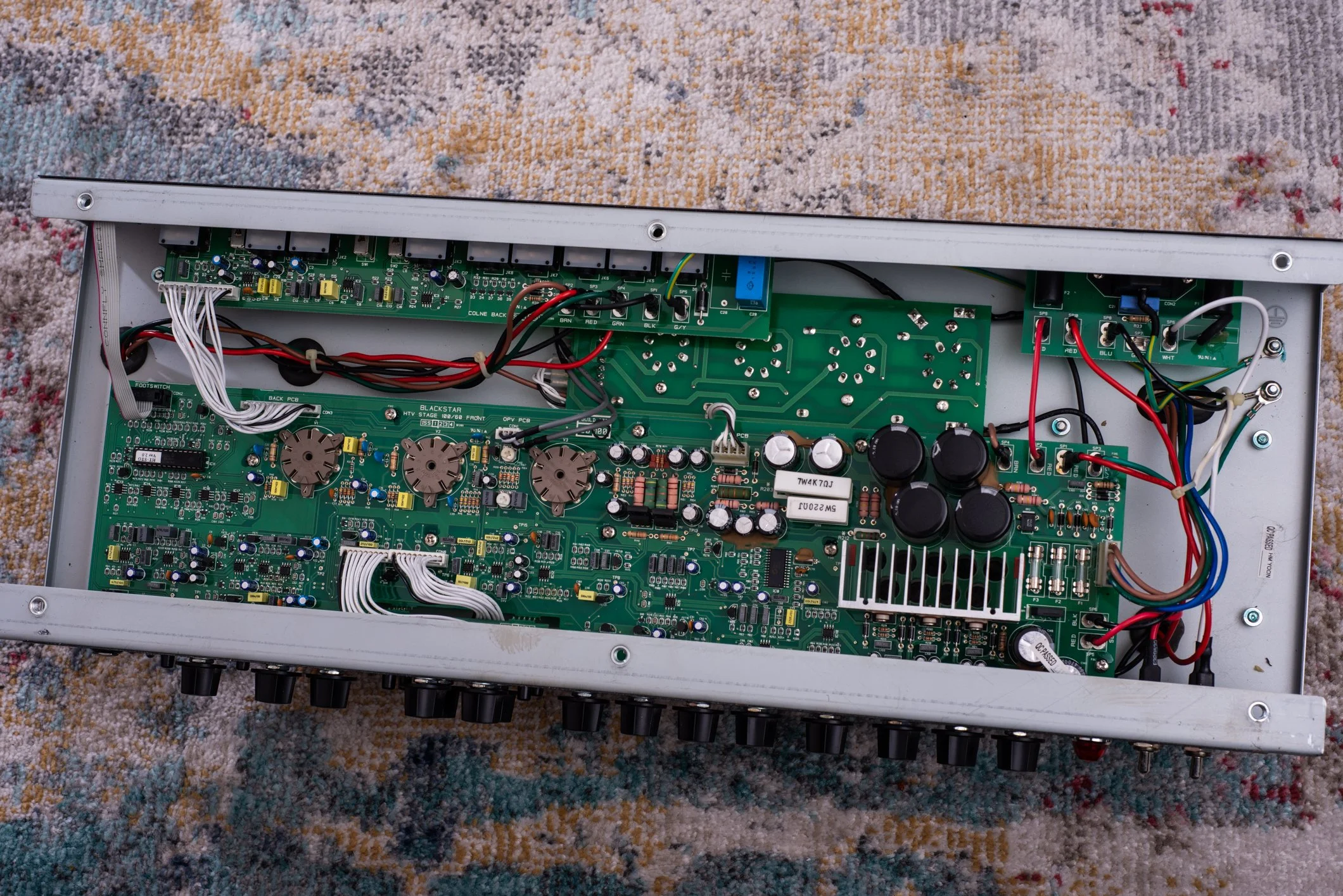2011 Blackstar HT-100 Stage
Specs
3 Channels
100w Output
4x EL34 Power Tubes
2x 12AX7 Preamp tubes
1x 12AU7 Phase Inverter
Direct line output with cab emulator (1x12 or 4x12)
Digital reverb
$1069 in 2010
Overview
This amp, and the others in the Blackstar HT series, were very popular in my area when I was in college and still just getting my bearings playing guitar. The HT5 was especially popular, but I always wanted the HT60 or HT100’s so I could have the two distortion channels in addition to the clean (the other HT series amps were two channels - clean/drive). I used to go to a local shop in Statesboro GA called “Deloach’s Music” and while college kids generally weren’t allowed to sit around and jam (for obvious reasons), I’d gotten my first Kramer Pacer fixed up by them with new pickups and wiring, and got on good terms with the guys that worked there.
They were nice enough to let me into the back room, which at the time was truly a dream - they had several of Mesa Dual Rectifiers, Peavey 6505’s, and other high gainers. They let me jam back there, demoing whatever amps I wanted and I really planned to buy a Dual Recto. However something about this HT-100 always spoke to me, it felt easy to play, sounded really good, and I really liked the reverb and ISF controls. I didn’t know anything about circuit design, speakers, or even boosting - I was just playing on my Vox AD30VT back then. After a few sessions, I left with a really positive impression of this amp and at around $800 brand new, and a Rectifier running closer to $1800, I was very tempted. Ultimately, I ended up buying a used Marshall JCM2000 TSL which was my first tube amp.
Skip forward a few years, and I’ve collected quite a few high end amps since then and learned a lot more about not only what tone I want, but how to get it with speakers, pedals, pickups, EQ’s and so on. I always wanted to try one of these out again but they aren’t very well regarded anymore and even though I remember the lower wattage models selling like crazy (HT5, HT20), I never really thought to buy one of these and find out if I still think it sounds good over ten years later. On a whim, I stopped at my local Sam Ash and saw this head sitting in the clearance section and after a quick demo to make sure everything worked, I couldn’t resist and bought it on the spot.
Once I got it home, I have to say I am still really impressed with this amp. If you ignore all of the complaints about solid state components, diodes, op-amps, whatever - it’s just a really good sounding amp. The drive channels are voiced very similarly, but OD2 has a bit more gain. The “Voice” switch has a drastic effect on the tone, so you can make them sound quite different by having the Voice switch in on one channel and not the other. I think OD1 with the voice switch in does a pretty mean Marshall style crunch tone with the gain below half and combined with the ISF control it has a really wide range in addition to the standard treble/middle/bass tone stack. OD2 can do metal rhythm right out of the box with no boost required, and the chugs sound full and powerful, and you can tune it really well with the presence and resonance controls. I’d even say the clean channel is very good, with two different modes, one with a little more bite.
The amp really has two detractors. The global reverb control is severely limiting, since you may want some reverb on your clean tones, but less on your crunch or high gain sounds, but it can’t really do that. Of course, you can turn off the reverb from the footswitch when you switch channels but that’s the second major issue - the footswitch is a 4-button unit with the strangest connector I’ve ever seen. It looks like a VGA or Parallel port connector, with multiple pins on the amp side, and it screws in place. When I got this amp, they didn’t have the footswitch and I actually spent months checking online for the footswitch (“FS-7” is burned into my brain) before I finally found one on Reverb. I’m sure the footswitch could be converted to some other type of connector, and weird footswitch connectors aren’t too uncommon but it’s a shame it isn’t just two 1/4” jacks or something easier to find a replacement for. One more minor nitpick, I also would’ve liked to have separate ISF/Treble/Middle/Bass controls for both OD1 and OD2. It’s certainly usable as it is, but the voice switches give you so much versatility it’s a shame to stop just short of being really excellent and having separate EQ’s, for example if you were using OD1 as your crunch tone and OD2 as a solo tone and wanted them to sound different from each other besides just the amount of gain.
Still, I think this amp has held up really well over time and considering I regularly see them priced below $400 USD, I’d consider it a great value “sleeper” amp on par with something like the Peavey XXX.









